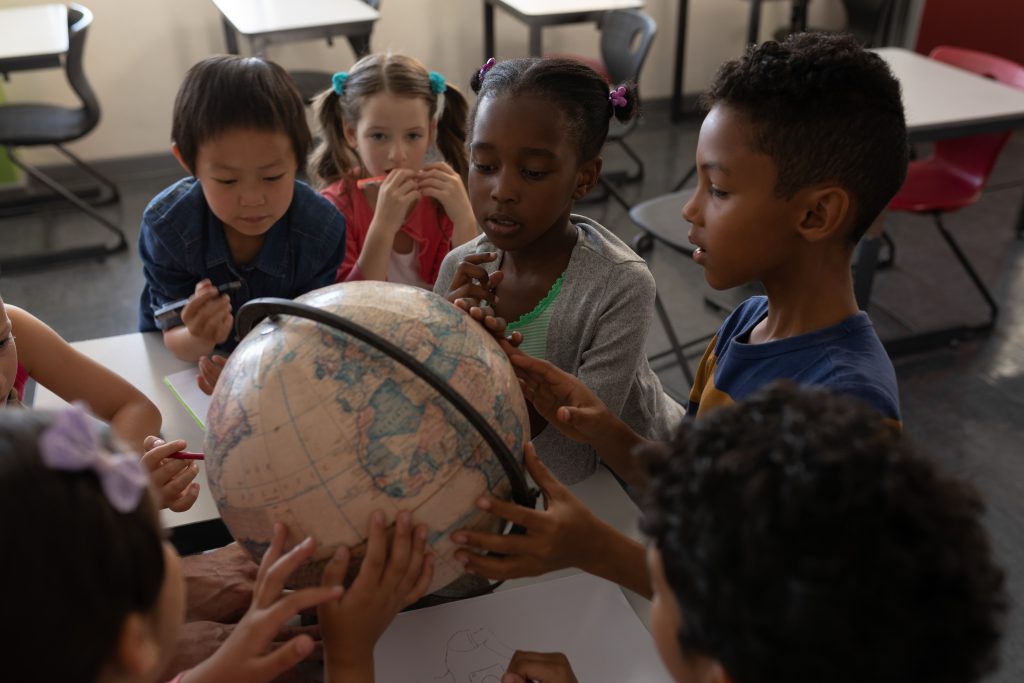“Education is not preparation for life; education is life itself.” — John Dewey
Education is a key factor, or perhaps, the only factor for individuals and societies to make progress. Although it is a basic right for every human being to be educated, education is not the same around the world. Privileged people and countries benefit from it; there are many more who lack this fundamental right, making them unprepared for the upcoming challenges in life. There are many negative factors across the globe that affect societies which lack proper education for their individuals; one negative factor leads to negative outcomes. (Jan Lee)
Factors such as high costs for schooling, lack of availability, and school supplies, disability, and family priority lead to negative outcomes for the future of these families and societies in general. These kids grow up without having learned basic skills in communication, math, and reasoning. Without these skills, they cannot contribute for themselves first and then for the society at large, causing the cycle of poverty to continue. (Mathew Lynch, HOW TO IMPROVE ACCESS TO EDUCATION AROUND THE WORLD)
“The purpose of education – as Marian Wright Edelman stated – is to improve the lives of others and for leaving your community and world better than you found it.”

As we stated at the beginning of the article, education is not the same across the globe; in some African countries, three out of four children do not understand the simplest grammar rules. In India, almost three-quarters of third-graders cannot solve a two-digit subtraction, and by grade five, half of them still cannot do so. There are many kids that go to school, but not all of them take advantage of it; hundreds of millions of kids reach adulthood without the basic skills of making a simple transaction or reading a doctor’s instructions. They will not have the skills and means to follow a career path or give better education to their own children. For a country, education strengthens the institutions within, leading to long-term economic growth, less poverty, and innovations in all walks of life. (The Education Crisis: Being in School is Not the Same as Learning)
Annette Dixon, Vice President of Human Development World Bank, gives us hope and encouragement by saying: “It’s never too late for young people to have opportunities to learn. Our youth deserves to be equipped with the skills they need to thrive in an increasingly demanding and uncertain job world. Given that today’s students will be tomorrow’s citizens and leaders, a good and relevant education is essential to turn aspirations into reality.” (The Education Crisis: Being in School Is Not the Same as Learning)
The major factors that affect education systems across the world are the proper use and management of resources to support these systems in different parts of the world. The wealth of a country directly affects the amount of money spent on education.
The same developing countries that lack basic necessities such as running water are unable to support education and, as a result, lack education. For example, in developing countries such as Kenya, the economy and geography plays a big role in education and its access. Girls in certain villages don’t have the means to go to school because they have to fetch fresh water for their families. If a well is built in one of these villages, the lives of these girls would change dramatically because they could go to school. (Janine Bowen, Ask the Expert: How is Education Different Around the World?)
Children in developing countries lack education due to inequality and marginalization. Even in developed countries, factors such as sex, cultural identity (ethnic origin, language, religion) make children find themselves on the margins of the education system and do not learn what is vital for their intellect and social development. Poverty, illiteracy of parents increase non-schooling and drop out by 2. (Right to education: Situation around the world)

Health problems because malnutrition plays a negative role in the future of these kids because they are forced to work from an early age to provide for their families.
Developing countries cannot support themselves with their education; they need foreign aid. Only 20% of aid education goes to these countries, and it costs only $1.25 per day in developing countries to provide 13 years of schooling. If these countries could invest only 15 cents more per child, it would make all the difference. The gap to provide quality education to all children by 2030 is $39 billion, while GPE encourages these countries to contribute 20% of their national budget to education, 45% of it to primary education. The problems do not end here, there are not enough teachers to teach in these countries, and those who teach are untrained. In Africa, there are not enough schools; children are forced to learn in overcrowded classrooms, classrooms fall apart, or the learning process takes place outside in the sun’s heat. They lack textbooks, school supplies, and other necessary tools. In Malawi, there is an average of 130 children per classroom in first grade; in Chad, 1 in 7 schools has potable water, and 1 in 4 has a toilet. (Rueckert Phineas 10 Barriers to Education That Children Living in Poverty Face)
One of the cruelest barriers to education is gender inequality. In most developing countries, girls have higher chances of being excluded from the right to education than boys. According to UNESCO, up to 80% who are currently out of school probably will never start school. This rate is 16% for boys. (11 UNEXPECTED BARRIERS TO EDUCATION AROUND THE WORLD)
Over 130 million young women around the world are not enrolled in school. One in three girls is married before the age of 18 and will drop out of school. Educating these girls benefits these families and societies, but they are often missed out due to prejudices that it is more worthwhile to educate a boy than a girl. Girls are forced to take care of younger siblings and work in homes. Girls are also embarrassed to participate in class due to a lack of hygiene and toilet facilities. (Rueckert Phineas 10 Barriers to education that children living in poverty face)
There are many children with a lot of potential and eager to learn but cannot due to a lack of access to transportation. Children are unsafe going from home to school, being endangered by climate, animals, or other humans.(Mathew Lynch, HOW TO IMPROVE ACCESS TO EDUCATION AROUND THE WORLD)
Using technology, designing lessons for learning at home, being mentored by older advanced students, providing safe means of transportation are methods to lower the number of children in this category from not going to school. (Janine Bowen, Ask the Expert: How is Education Different Around the World?)
Another negative factor worth mentioning is living in a country in conflict or at risk of conflict. There are many casualties among the civil population, and school institutions are destroyed. Children exposed to violence drop out of school. The number of children living in countries affected by conflicts is 250 million; more than 75 million children are currently in need of educational support in 35-crisis-affected counties. (Marusa Romih A Global Education Crisis: ) The conflict prevents everything from functioning; teachers and students flee their country to save their lives, and the learning process keeps disrupting. Without support from outside countries, these children will not be able to reach their full potential in order to rebuild their country and communities (Rueckert Phineas 10 Barriers to education that children living in poverty face)
Education is a fundamental right, and all human beings should access knowledge if we want a society and world to be better than what it was in the past. Technology can offer us the means by providing the learning materials in many countries, but this is very far-reaching in developing countries with so much work ahead to do. The situation is better than it was in the past, but still, there is a need for constant improvements. If we want change in any part of the world, we have to consider providing change for the better all across the world. There are charities, organizations, and individuals who volunteer to make a better change in education worldwide. Education empowers and enlightens individuals and societies, and we cannot deny the importance it has in our lives. This is a cause worth standing for; it means standing for the future. (Marusa Romih, A Global Education Crisis: The Lack of Access to Education in Developing Countries )
References:
- Juma, Robert. February 2, 2021. 180 quotes About Education and the Power of Learning. EVERYDAY POWER.https://everydaypower.com/quotes-about-education/
- Marian Wright Edelman quotes in BrainyQuote.https://www.brainyquote.com/quotes/marian_wright_edelman_390612
- 11 Unexpected Barriers to Education Around the world. August. 15, 2019. Concern worldwide US. https://www.concernusa.org/story/barriers-to-education-around-the-world/
- Bowen, Janine. July 27, 2020. Ask the Expert: How is Education Different Around the World? College of Education News. https://ced.ncsu.edu/news/2020/07/27/ask-the-expert-how-is-education-different-around-the-world-teaching-philosophies-differ-but-we-all-want-what-is-best-for-our-students-says-friday-institute-executive-director-hill/
- Education Around the World. Lumen Learning. N.d. https://courses.lumenlearning.com/wm-introductiontosociology/chapter/education-around-the-world/
- January 22, 2019. The Education Crisis: Being in School Is Not the Same as Learning. THE WORLD BANK, https://www.worldbank.org/en/news/immersive-story/2019/01/22/pass-or-fail-how-can-the-world-do-its-homework
- Juma, Robert. February 2, 2021. 180 quotes About Education and the Power of Learning. EVERYDAY POWER.https://everydaypower.com/quotes-about-education/
- Lee, Jan. Jul 25, 2018. How to Improve Access to Education Around the World. TRIPLEPUNDIT. https://www.triplepundit.com/story/2018/how-improve-access-education-around-world/12506
- Lynch, Mathew. September 2, 2019. HOW TO IMPROVE ACCESS TO EDUCATION AROUND THE WORLD. THE EDVOCATE. https://www.theedadvocate.org/how-to-improve-access-to-education-around-the-world/
- Right to Education: Situation around the world. Humaninum n.d., https://www.humanium.org/en/right-to-education/#:~:text=Today%2C%20education%20remains%20an%20inaccessible,and%20those%20of%20their%20children
- Romih, Marusa. N.d. A Global Education Crisis. https://www.unsustainablemagazine.com/a-global-education-crisis-the-lack-of-access-to-education-in-developing-countries/
- Rueckert, Phineas. Aug 13, 2019. 10 Barriers to Education That Children Living in Poverty Face. GLOBAL CITIZEN. globalcitizen.org/en/content/10-barriers-to-education-around-the-world-2/





















